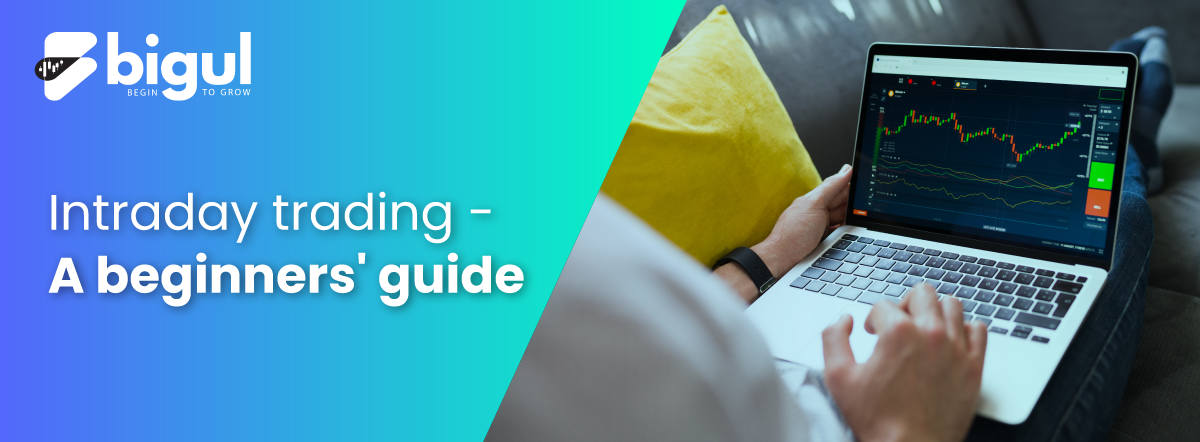What is Intraday Trading?
Intraday trading is the practice of purchasing and selling equities during the same trading day. In this process, stocks are purchased with profit-making goals rather than investing goals. This is accomplished by taking advantage of the movement of stock indices, which implies that fluctuating stock prices are taken advantage of to generate profits from trading stocks.
Intraday trading indicates the act of purchasing and selling equities on the same trading day using online platforms. If someone wants to buy intraday stock, they have to select the type of Order as “Intraday” in the trading. This help trader to take benefit from price fluctuation on the same day. Many people also refer to it as day trading.
Click here to Start Trading Now
Example
Let’s say a stock start trading the following morning at Rs 600; within a couple of hours, it quickly increases to Rs 650. If you had acquired 1,000 equities in the morning and sold them for Rs 650, you would have made a decent profit of Rs 50,000 within a few hours. This is known as Intraday trading.
Selection of Stocks for Intraday Trading
Before we choose a stock for intraday trading, it is important to understand that as an investor, you do not have the comfort of keeping stock, so making the incorrect selection could result in substantial losses. Stocks need to have a few qualities to be purchased and sold in a single day. These consist of the following:
- High demand
- Buy low and sell high on price volatility
- Market trends
- Sector trends
- Stocks Momentum
- Technical Analysis
Liquidity
A stock’s liquidity must be adequate to ensure that you can buy and sell stocks at any moment. The aspect of buying equities with high liquidity is that they usually have significant volumes. Hence, it can be bought and sold in large amounts without affecting the stock price.
When choosing highly liquid stocks take different price levels into account. After a certain point volume may swiftly decline even though few stocks can trade at lower prices with a lot of liquidity. By being informed about this, you can buy them when it is appropriate.
Volatility
When the price fluctuates as per the day trader’s anticipation, they tend to get profit. If the price doesn’t move as per the traders’ anticipation, they could occasionally book losses. Traders can take advantage of favorable changes in price to place more intraday orders while the stock prices seem unpredictable. But remember that investing in major volatile equities can backfire if the gain or fall in stocks is too sharp. Intraday traders select stocks that frequently move on an average of 3–5% in each direction as there is no particular set rule.
Market Trends
Markets typically go upward or downward based on economic, political, social, and other variables. Correlation between stocks and markets implies that stock values may climb or decline depending on how well the markets perform. Therefore, keeping this correlation in mind while purchasing stocks for intraday trading is crucial.
Sector Trends
Banking, FMCG, Oil & Gas, Pharmaceuticals, Automotive, and Technology are the several categories in which the market is classified.
The status of the overall economy must be monitored closely by intraday traders. If you observe companies that have been integrating for several months and are poised to break out, look for them to make your investments in the identified sector(s).
Additionally, if you cannot profit from the trend, you can find companion stocks that have seen a significant rise from the same sector in the potential breakout area.
Momentum of Stocks
A stock’s momentum is defined as the rate of change in a stock’s price over time. You can use this to identify the strength of an upward or downward trend in the stock price.
If the stock price moves vigorously in line with the momentum is called a momentum stock. Traders who trade during intraday use these stocks to go long (upward trend) or short (downward trend) to make a profit.
Short Selling in the Stock Market
Short selling involves opening a position by selling shares that a trader does not own but has instead borrowed from a broker-dealer. They short the position by selling it at the current market rate and wait for prices to fall. In order to close a short position, traders eventually have to purchase back the equities they sold short.
If prices fall, traders earn profit from the gap between the selling and the purchasing price. However, the concerned trader will lose if the price fall prediction is incorrect and the share price rises instead.
Conclusion
Remember that choosing the correct stocks is crucial to profit from intraday trading. At the same time, the above advice can assist you in finding them. Over time you will learn which methods of stock selection suit you the most.
To profit from intraday trading, ensure that you maintain objectivity, rely on statistics, and refrain from making emotional decisions.

.jpg)






.jpg)
.jpg)
